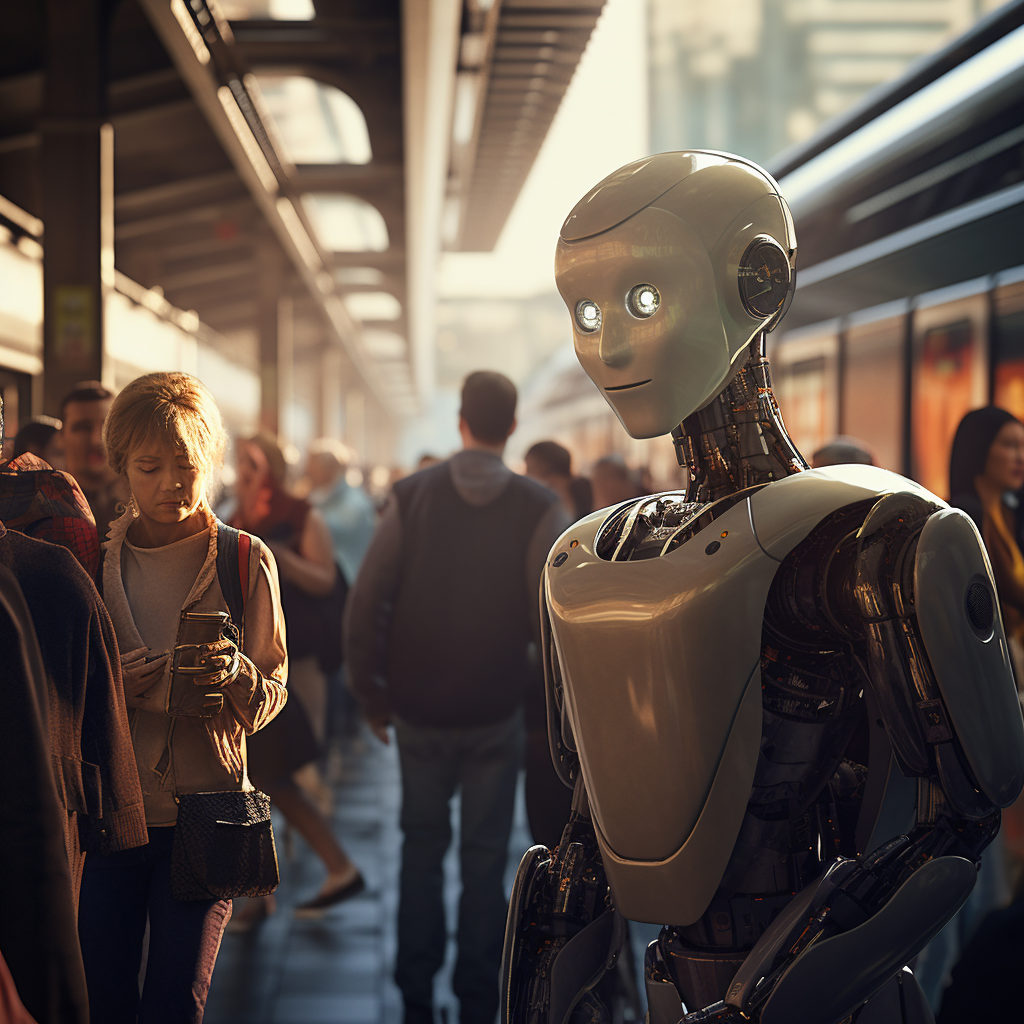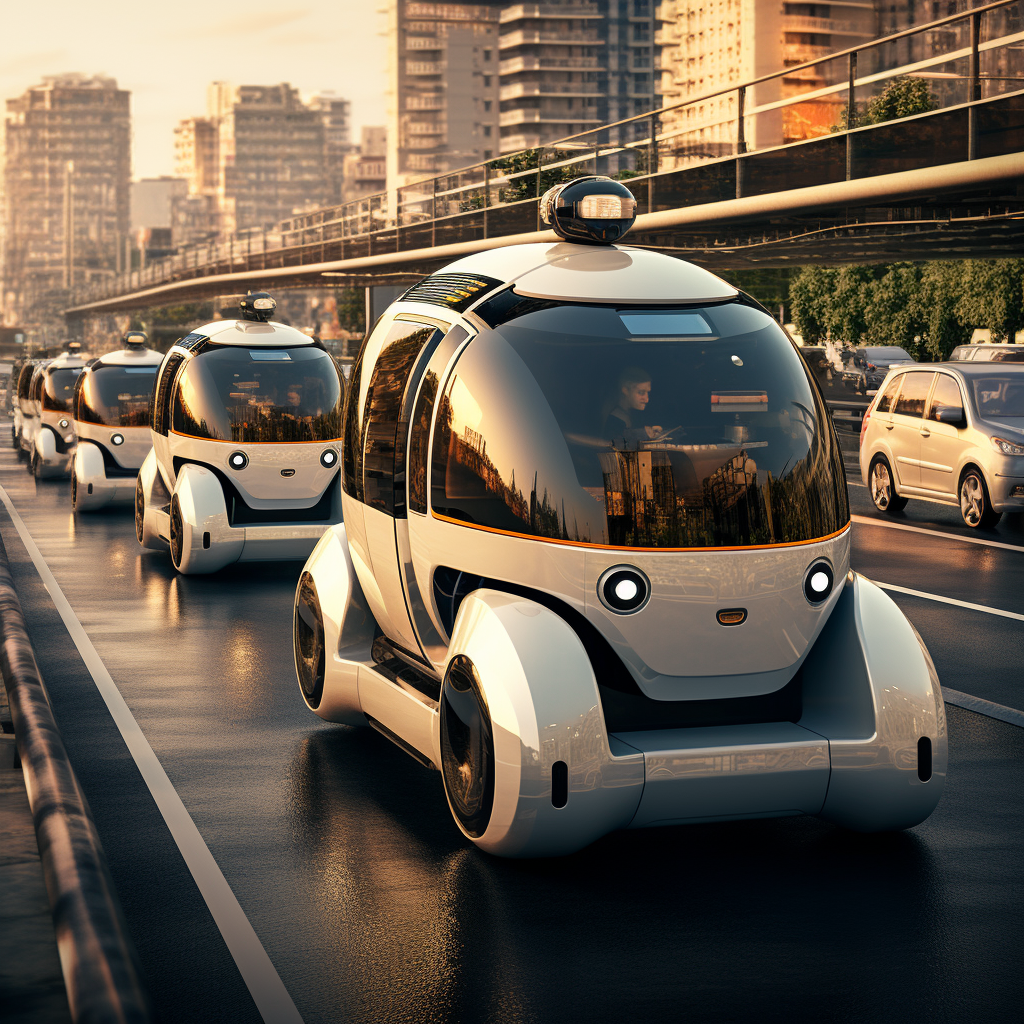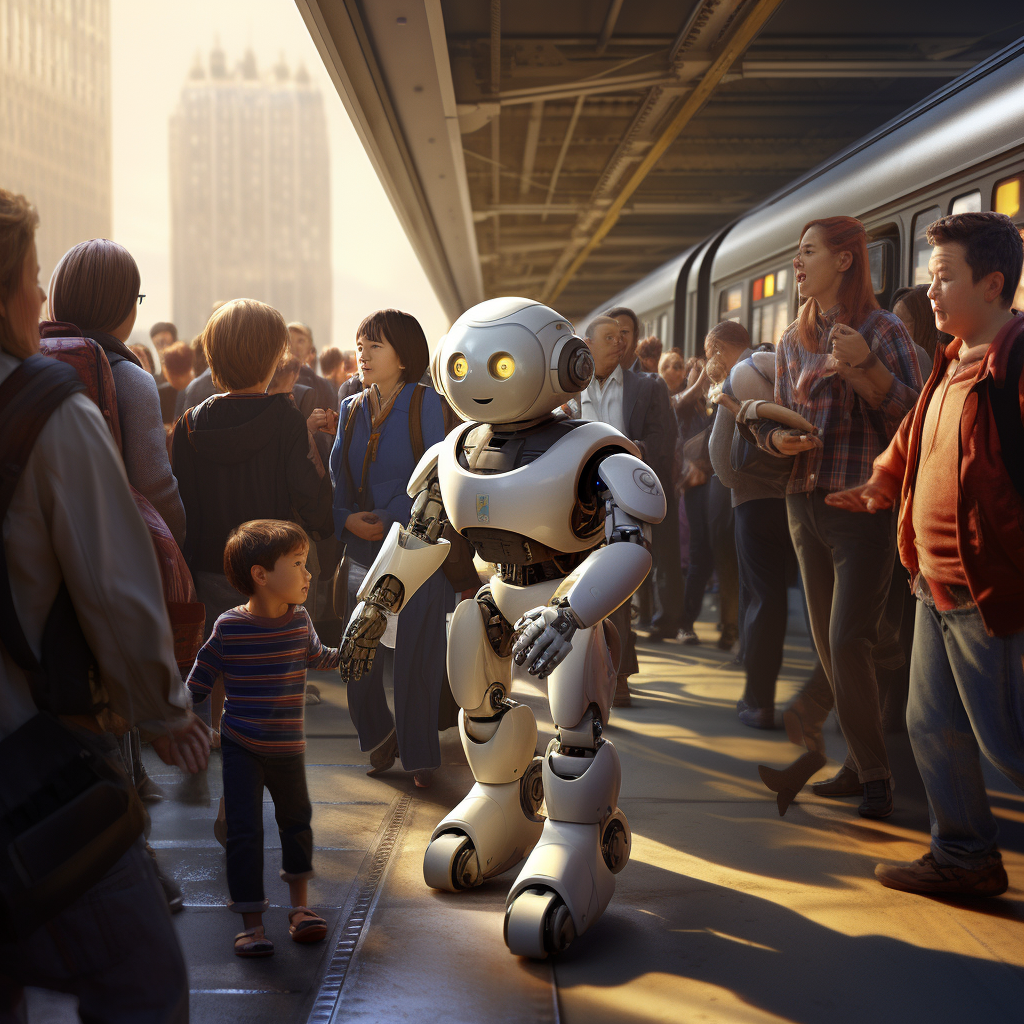On a crisp autumn morning in Tokyo, amidst the bustling crowds and the rhythmic cadence of footsteps, I encountered the future. A robot, sleek and unassuming, was assisting passengers onto a train, its sensors adeptly navigating the chaos of rush hour. This moment, fleeting yet profound, was a window into a world where humanity and robotics converge, reshaping the very fabric of our daily commutes.
The integration of robotics into public spaces, especially transportation, isn't just about convenience or efficiency—it's a philosophical transformation. As robots find their place alongside us, our shared spaces become arenas of symbiosis. How do these mechanical entities, governed by codes and algorithms, fit into the organic ebb and flow of human life? How does technology redefine the essence of public spaces, places where strangers become momentary travel companions, each with their own stories, destinations, and dreams?
We stand at a nexus, a point in history where our technological aspirations intertwine with our age-old desire for connection and community. As we embark on this exploration of robots in public transportation, we must ponder not just the how, but the why. Why do we seek robotic companionship in our travels? And as these robots board our trains and buses, what reflections of humanity do they carry with them?
The Efficiency Quotient: Beyond Timetables and Routes

The rhythmic cadence of a train arriving punctually, the subtle whisper of bus doors opening in synchrony with a scheduled time - such moments have always been the hallmark of an efficient public transportation system. But, as we delve deeper into the annals of time, we realize that the concept of 'efficiency' in transportation was once a luxury, not a given.
In the early days of public transit, horse-drawn carriages and steam-powered trains were marveled at, not for their timeliness, but for their sheer existence. Fast forward to the present, and the narrative has shifted. Now, mere existence is not enough; precision is demanded. And in this quest for perfection, robots have emerged as the unsung maestros, orchestrating a symphony of timely arrivals and departures.
Yet, this transformation isn't just about adhering to schedules. It's about understanding human patterns, predicting flow, and preempting challenges. With the integration of robotics, transportation systems worldwide can now process vast amounts of data in real-time, making dynamic adjustments to optimize routes and reduce wait times. This not only ensures that your train arrives on time but also that your journey is smooth, unhindered by unforeseen delays.
But, as we bask in the marvels of this newfound efficiency, a philosophical question beckons: In our pursuit of robotic precision, are we losing the serendipity of unplanned moments? The unexpected joy of a delayed train leading to a chance encounter or a rerouted bus offering a glimpse of an unexplored neighborhood? As robots streamline our paths, do we risk streamlining our experiences as well?
While the benefits of robotic efficiency in public transit are undeniable, as we journey through this evolving landscape, it's essential to remember that sometimes, the journey itself, with all its unpredictability, is as valuable as the destination.
Safety First: The Robotic Guardians of Transit
In the dimly lit corridors of a metro station in Seoul, a mother clutched her child's hand, their shadows dancing on the walls as they hurried towards the approaching train. As they neared the platform's edge, a sudden misstep sent the child's toy tumbling towards the tracks. In that heart-stopping moment, a robotic arm swiftly intervened, retrieving the toy and preventing a potential tragedy. This wasn't just machinery at work; it was a guardian, a silent sentinel ensuring safety in the midst of life's unpredictability.
Transportation, for all its marvels, has always been accompanied by a shadow of risk. From the early days of rickety carriages to today's high-speed trains, ensuring passenger safety has been a perpetual challenge. However, as the narrative of transportation evolves, robots are emerging as the new vanguards, turning these challenges into opportunities for enhanced security.
With an array of sensors and unparalleled processing capabilities, robots can anticipate and mitigate risks in real-time. Whether it's detecting track obstructions, managing crowd flow, or assisting during emergencies, their presence promises a future where mishaps are not just minimized but potentially eradicated.
Yet, as we welcome this new age of robotic guardians, an ethical quandary surfaces. With every intervention, robots tread the fine line between surveillance and safety. How do we balance the need for security with the preservation of personal freedoms? As machines watch over us, who, in turn, watches over them?
Historically, the safety of public spaces, including transportation hubs, has been a shared responsibility, a pact between individuals and the community. But as robots become the new custodians, our relationship with safety is no longer just communal; it's collaborative.
In this dance between man and machine, it's crucial to remember that robots, no matter how advanced, are tools shaped by human intent. Their role in our safety isn't just about prevention but also about trust—a trust that they will act in our best interest and a hope that we will use them wisely. In this evolving narrative, it's not just about reaching our destinations safely, but journeying with the assurance that our robotic companions are with us, every step of the way.
A Journey Beyond Convenience: The Robot-Passenger Experience
In the vibrant heart of Barcelona, an elderly man named Eduardo boarded the city's newest autonomous tram. As he settled into his seat, a robotic assistant approached, offering a digital interface tailored to his needs. With a soft touch and a few spoken words, he was transported not just through the city but through memories of past journeys. This wasn't just transit; it was an experience, a harmonious blend of technology and nostalgia.
The marriage of robotics and public transportation isn't just about utility; it's about crafting an experience that resonates on a deeply human level. As we embrace the future, our commutes are being transformed from mere routines into immersive narratives, sculpted by the delicate interplay between human emotion and robotic capability.

For the weary traveler, a robot might offer a comforting song or a gentle reminder of home. For the curious child, an interactive story or a virtual window into the world's wonders. These aren't just features; they're bridges, connecting our innermost desires to the vast potential of technology.
However, as robots become integral to our transit experiences, a poignant question emerges: How do we ensure that this symbiotic relationship remains authentic? In an age where digital interactions often eclipse face-to-face connections, how do we ensure that our robotic companions complement rather than replace the human touch?
The history of transportation is a tapestry of innovation and emotion. From the intimate stories shared on long train journeys to the fleeting glances exchanged in busy metro stations, these moments, though transient, form the essence of our shared humanity. As robotics infuse new magic into this tapestry, we are reminded that at the heart of every journey is a story, waiting to be told and retold.
In this brave new world, the challenge isn't just about integrating robots; it's about crafting experiences that resonate, that evoke emotion, and that remind us that even in the heart of machinery, there's a beat that's profoundly human.
Navigating the Future: Challenges and Promise on the Robotic Horizon
Amidst the bustling streets of Tokyo, a vision from the future unfolds. Autonomous buses weave seamlessly through traffic, their paths illuminated by the soft glow of LED lights. Inside, passengers engage with robotic interfaces, their interactions fluid, almost poetic. But beyond this utopian facade lies a deeper narrative, one of challenges faced and lessons learned.
The integration of robotics into public transportation is akin to charting unknown waters. For every beacon of progress, there are shadows of uncertainty. How do we ensure that these robotic systems are inclusive, catering not just to the tech-savvy youth but also to the elderly, the differently-abled, and those wary of technology's rapid embrace?
As we stride forward, we're also confronted with the ethical maze that the convergence of AI and transportation presents. If an autonomous vehicle faces an unavoidable accident, how does it choose a course of action? Whose safety does it prioritize? The passengers', the pedestrians', or its own? These are not just technological challenges but profound moral conundrums, ones that require introspection and dialogue.
Yet, in this intricate dance between progress and challenge, there's an undeniable allure. The promise of a world where commutes are not just efficient but deeply personal, where every journey is an experience, and where technology serves not as a disruptor but as a harmonious partner.
Drawing inspiration from history, we find that every great leap, from the invention of the wheel to the dawn of aviation, has been accompanied by its set of challenges. But it's in navigating these challenges that humanity's resilience and ingenuity shine brightest.
As we stand on the cusp of this robotic renaissance in public transportation, we are not just passengers or observers. We are co-creators, shaping a narrative that will define generations to come. It's a journey rife with challenges but illuminated by the promise of a future where machines and humans coexist, learn, and journey together.
Empathy in Automation: Building Bridges, Not Barriers

In the heart of London, a child gazes in wonder at a public bus, its smooth movements and gentle hum reminiscent of a creature from a storybook. To her, this isn't just a machine; it's a gentle giant, a guardian of the streets. Nearby, an elderly gentleman, hesitant at first, extends his hand to touch the robotic interface that assists passengers, a fleeting moment of human-machine connection.
This intersection of technology and emotion, of cold steel and warm hearts, prompts a crucial reflection:
How do we design robots that resonate with our innate human sensibilities?
Delving deep into history, we unearth narratives of humanity's age-old yearning to animate the inanimate. From the mythical Greek sculptor Pygmalion, who fell in love with a statue he carved, to the ancient Chinese legends of automatons that could mimic human actions, there's a deep-rooted desire to breathe life into our creations. This isn't merely an artistic or technological pursuit; it's a profound exploration of our own humanity.
In the realm of public transport, the challenge isn't just to create efficient robotic systems but to foster genuine human-robot empathy. Can a robot sense a passenger's anxiety during a crowded commute and respond with calming ambient music? Can it detect the subtle tremors of an elderly person's hand and adjust its interface for easier use?
At the intersection of these queries lies an ethical dimension. Just as a sculptor infuses a sculpture with love and intent, how do we ensure that our robotic creations are imbued with principles of compassion, respect, and inclusivity?
The cultural tapestry of our globalized world further enriches this narrative. In Tokyo, robots may be seen as companions, while in New Delhi, they might be viewed with a mix of curiosity and caution. Understanding and respecting these cultural nuances is paramount.
In this grand odyssey of innovation, as we strive for efficiency and precision, let's not forget the heartbeats, the whispers, the silent hopes, and dreams of those who embark on these journeys. For in the end, it's not just about reaching a destination; it's about the stories we weave, the connections we forge, and the horizons we envision together.
The Ethical Nexus: Where Machine Meets Morality
In the bustling streets of Cairo, a mother holds her child's hand tightly as they board a newly introduced robotic tram. The child's eyes, filled with a mix of wonder and trepidation, reflect a larger societal sentiment. As the wheels of progress turn, casting shadows of the past, we find ourselves at a crossroads, teetering between awe and anxiety.
It's undeniable that the infusion of robotics into public transit has brought about unprecedented efficiency. But behind this shimmering veneer of progress lies a labyrinth of moral and philosophical conundrums. What happens when an automated system faces an unforeseeable ethical dilemma? When split-second decisions need to be made, whose lives are prioritized? The child who's just stepped onto the tracks? The elderly couple on board?
Such quandaries take us back centuries, echoing the trolley problem, a philosophical thought experiment. Here, we're not merely replacing the trolley with a robotic tram but adding layers of complexity with AI's decision-making algorithms.
Drifting eastward to the serene temples of Kyoto, monks meditate on the impermanence of life. Yet, amidst this tranquility, they too ponder over the role of machines in our lives. One monk muses,
"If a robot is programmed to save a life, does it carry the same karmic weight as a human act of bravery?"
Across the world, in the lecture halls of Harvard, spirited debates ensue. Scholars argue whether we're merely projecting our own ethical biases onto these machines. The European perspective might prioritize the elderly, given their societal reverence, while other cultures might value the vibrancy of youth. Whose ethics do we encode?
The canvas of history, painted with tales of Prometheus and Pandora's Box, serves as a poignant reminder. With every stride in innovation comes responsibility. As we stand on the cusp of a new era, we must ask: Are we, as creators, ready to bear the weight of our creations' actions?
The intertwining of machine logic with human emotion, of binary with morality, is a dance as intricate as it is profound. And as the curtain rises on this new act, the world watches, hopeful and wary, waiting to see where the rhythm takes us next.
The future of AI and robotics is not just about technology; it's about reimagining the very essence of humanity. Stay curious for the next chapter. 🤖✨





